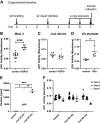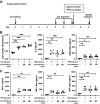Impact of e-cigarette aerosol on primary human alveolar epithelial type 2 cells
- PMID: 35670478
- PMCID: PMC9559034
- DOI: 10.1152/ajplung.00503.2021
Impact of e-cigarette aerosol on primary human alveolar epithelial type 2 cells
Abstract
Electronic cigarettes (e-cigarettes) are designed to simulate combustible cigarette smoking and to aid in smoking cessation. Although the number of e-cigarette users has been increasing, the potential health impacts and biological effects of e-cigarettes are still not fully understood. Previous research has focused on the biological effects of e-cigarettes on lung cancer cell lines and distal airway epithelial cells; however, there have been few published studies on the effect of e-cigarettes on primary lung alveolar epithelial cells. The primary purpose of this study was to investigate the direct effect of e-cigarette aerosol on primary human lung alveolar epithelial type 2 (AT2) cells, both alone and in the presence of viral infection. The Melo-3 atomizer caused direct AT2 cell toxicity, whereas the more popular Juul pod's aerosol did not have a detectable cytotoxic effect on AT2 cells. Juul nicotine aerosol also did not increase short-term susceptibility to viral infection. However, 3 days of exposure upregulated genes central to the generation of reactive oxygen species, lipid peroxidation, and carcinogen metabolism and downregulated key innate immune system genes related to cytokine and chemokine signaling. These findings have implications for the potentially injurious impact of long-term use of popular low-power e-cigarette pods on the human alveolar epithelium. Gene expression data might be an important endpoint for evaluating the potential harmful effects of vaping devices that do not cause overt toxicity.
Keywords: EVALI; alveolar type II cells; e-cigarettes; inflammation; pulmonary edema.
Conflict of interest statement
C.S.C. has received grants and personal fees from Bayer and GlaxoSmithKline, personal fees from Boehringer Ingelheim, CSL Behring, Prometic, and Roche/Genentech. M.A.M. has received grants from Bayer Pharmaceuticals and GlaxoSmithKline, personal fees from Boehringer Ingelheim, Cerus Therapeutics, CSL Berhing, Quark Pharmaceuticals, Roche-Genentec, and Thesan Pharmaceuticals. None of the other authors has any conflicts of interest, financial or otherwise, to disclose.
Figures








Similar articles
-
Effects of mango and mint pod-based e-cigarette aerosol inhalation on inflammatory states of the brain, lung, heart, and colon in mice.Elife. 2022 Apr 12;11:e67621. doi: 10.7554/eLife.67621. Elife. 2022. PMID: 35411847 Free PMC article.
-
Cell-specific toxicity of short-term JUUL aerosol exposure to human bronchial epithelial cells and murine macrophages exposed at the air-liquid interface.Respir Res. 2020 Oct 17;21(1):269. doi: 10.1186/s12931-020-01539-1. Respir Res. 2020. PMID: 33069224 Free PMC article.
-
Understanding potential mechanisms of harm: the drivers of electronic cigarette-induced changes in alveolar macrophages, neutrophils, and lung epithelial cells.Am J Physiol Lung Cell Mol Physiol. 2021 Aug 1;321(2):L336-L348. doi: 10.1152/ajplung.00081.2021. Epub 2021 May 19. Am J Physiol Lung Cell Mol Physiol. 2021. PMID: 34009037 Review.
-
Effects of e-cigarettes and vaping devices on cardiac and pulmonary physiology.J Physiol. 2020 Nov;598(22):5039-5062. doi: 10.1113/JP279754. Epub 2020 Oct 12. J Physiol. 2020. PMID: 32975834 Free PMC article. Review.
-
Nicotine in E-cigarette aerosol may lead to pulmonary inflammation.Respir Med. 2025 Jun;242:108101. doi: 10.1016/j.rmed.2025.108101. Epub 2025 Apr 14. Respir Med. 2025. PMID: 40239848 Clinical Trial.
Cited by
-
Aerosolized nicotine from e-cigarettes alters gene expression, increases lung protein permeability, and impairs viral clearance in murine influenza infection.Front Immunol. 2023 Mar 14;14:1076772. doi: 10.3389/fimmu.2023.1076772. eCollection 2023. Front Immunol. 2023. PMID: 36999019 Free PMC article.
-
In Vitro assessments of ENDS toxicity in the respiratory tract: Are we there yet?NAM J. 2025;1:100016. doi: 10.1016/j.namjnl.2025.100016. Epub 2025 Apr 3. NAM J. 2025. PMID: 40264558 Free PMC article.
-
Smoking and vaping alter genes related to mechanisms of SARS-CoV-2 susceptibility and severity: a systematic review and meta-analysis.Eur Respir J. 2024 Jul 25;64(1):2400133. doi: 10.1183/13993003.00133-2024. Print 2024 Jul. Eur Respir J. 2024. PMID: 38991709 Free PMC article.
-
Chronic airway inflammatory diseases and e-cigarette use: a review of health risks and mechanisms.Eur J Med Res. 2025 Apr 1;30(1):223. doi: 10.1186/s40001-025-02492-9. Eur J Med Res. 2025. PMID: 40170170 Free PMC article. Review.
References
-
- Hammond D, Reid JL, Rynard VL, Fong GT, Cummings KM, McNeill A, Hitchman S, Thrasher JF, Goniewicz ML, Bansal-Travers M, O'Connor R, Levy D, Borland R, White CM. Prevalence of vaping and smoking among adolescents in Canada, England, and the United States: repeat national cross sectional surveys. BMJ 365: l2219, 2019. [Erratum in BMJ 370: m2579, 2020]. doi:10.1136/bmj.l2219. - DOI - PMC - PubMed
-
- Lozier MJ, Wallace B, Anderson K, Ellington S, Jones CM, Rose D, Baldwin G, King BA, Briss P, Mikosz CA; Lung Injury Response Epidemiology/Surveillance Task Force. Update: demographic, product, and substance-use characteristics of hospitalized patients in a nationwide outbreak of E-cigarette, or vaping, product use-associated lung injuries—United States, December 2019. MMWR Morb Mortal Wkly Rep 68: 1142–1148, 2019. [Erratum in MMWR Morb Mortal Wkly Rep 69: 117, 2020]. doi:10.15585/mmwr.mm6849e1. - DOI - PMC - PubMed
Publication types
MeSH terms
Substances
Grants and funding
LinkOut - more resources
Full Text Sources
Medical

